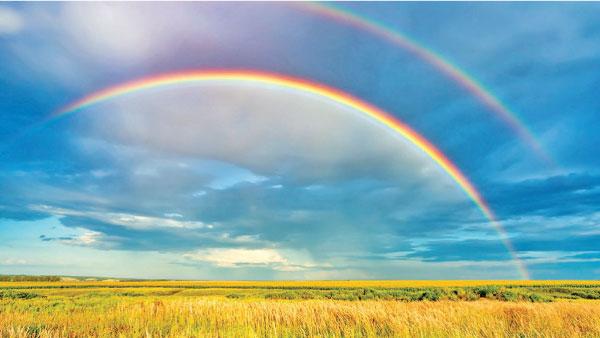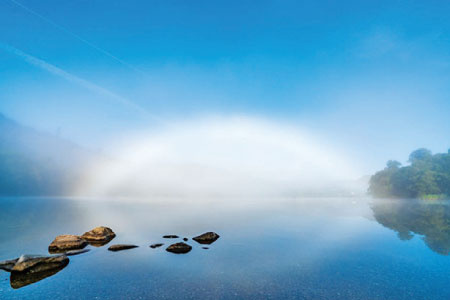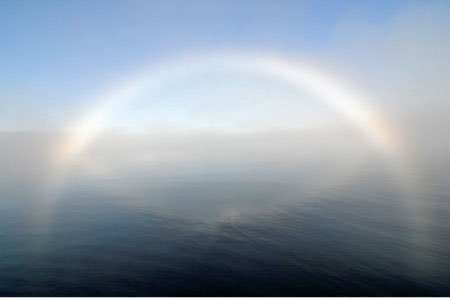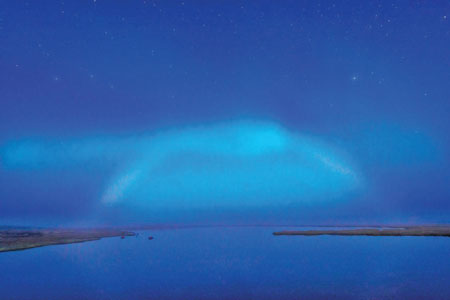
Rainbows develop when sunlight passes through falling raindrops. The speed of light is fast. As it passes through water, however, it slows a lot. Physicists refer to this as attenuation (Ah-ten-yu-AY-shun). That same slowdown occurs when sunlight shines through a raindrop.
Rob Hart is the lead meteorologist for the National Weather Service in Charleston, W.V. “Sunlight actually has all kinds of colours in it,” he explains. “When the sunlight passes through raindrops, the water makes the sunlight bend.” Scientists refer to that bending as refraction.
Scientists Say: Refraction
Because each hue has a slightly different wavelength, each slows and refracts a different amount. That refraction separates the colours and sends them out of the raindrop heading in slightly different directions. This transforms the sun’s light into a gorgeous arc across the sky.
Once in a while, the sunlight entering a raindrop is especially intense. When this happens, Hart notes, “Only certain parts and colours of the sunlight make it through.” A little bit of the leftover light reflects - bounces - off of the inside edge of the raindrop.
When that faint light hits the other side, it’s already been split apart into its colours. And because it’s a reflection, the colours have been reversed. That’s why, when you see a double rainbow, the secondary arc is much dimmer and its colours are flipped. It’s truly a 'mirror image' of the primary arc.
Rainbows form opposite the sun. So to see one, make sure your back is to the sun and the rain in front of you. These colourful arcs usually develop in summer following an afternoon storm.
Rainbows come in many shapes and sizes. “The higher in the sky the sun is, the more challenging it is for the sunlight to bend enough to produce the colours of a rainbow,” says Hart. “Only very small rainbows are possible. But if the sun is lower in the sky, the better the chances are of a rainbow showing up. Those rainbows can be much bigger.”
That’s why if you see a rainbow at noon, it’s probably just barely above the ground. But if you see one at sunset, it will tower high into the sky.
Their colours can vary, too.
When the arcs form around sunrise or sunset, they tend to be almost totally red. The reason: When the sun is close to the horizon, its light penetrates through the atmosphere slantwise. That filters out more of the blue, green, yellow and violet hues. The result is a nearly one-colour rainbow that blazes a fiery red-orange.
Ghostly cousins
And did you know rainbows can literally go full circle? It’s true. If you’re on an airplane, a mountaintop or someplace high that offers a perspective down below, the rainbow won’t be an arc but a full circle.
With no ground below to stop the prism-ing effect, it just keeps going.
If you’ve ever seen a pale, eerie white arc high in the sky, you might mistake it for a rainbow’s ghost. No haunting spirit, it’s actually a fogbow. These form in much the same way as rainbows. Fog is a cloud of water vapour near to the ground. Like raindrops, the fog’s water can refract sunlight into its assorted hues. But hunting a fogbow down can be a challenge.
That’s because if you’re near fog, you’re probably inside it. Fog doesn’t tend to have a sharp 'edge' that permits sunshine to shine through it (as viewed from the ground).
How rare fogbows are “depends considerably on where you are on the planet,” says Les Cowley. He is a chemical physicist and creator of the popular website Atmospheric Optics. Fogbows need both fog and sunlight. So regions prone to frequent fog and mist - such as San Francisco Bay, mountains or the Arctic - tend to have more fogbows.
The sun’s placement is important, too. It must be behind you, with the fog in front of you. You also need to know what to look for, as the fogbow is oddly white. And that has to do with the water droplets’ size.
Those droplets in fog are much smaller than raindrops. Individual droplets in a fog bank may only be a tenth of a millimetre (0.004 inch) across. In contrast, a raindrop’s diametre can be 20 to 30 times that size. And here’s why that matters. Tinier droplets let in less light. That will cast a much more subtle band of light against the sky.
Smaller drops also refract less. Because the light doesn’t separate as widely, all of the colours overlap. That makes these bows mostly white, because white is the mix of all colours. Sometimes, there may be a hint of colour. A bit of red may develop on the outside and bluish-purple on the inside.
Occasionally, a prisming cloud will not be at ground level, but higher up. Its droplets will be a bit bigger than fog’s, too. If enough of these droplets are packed densely enough in an area, they too can form a bow.
(Internet)
